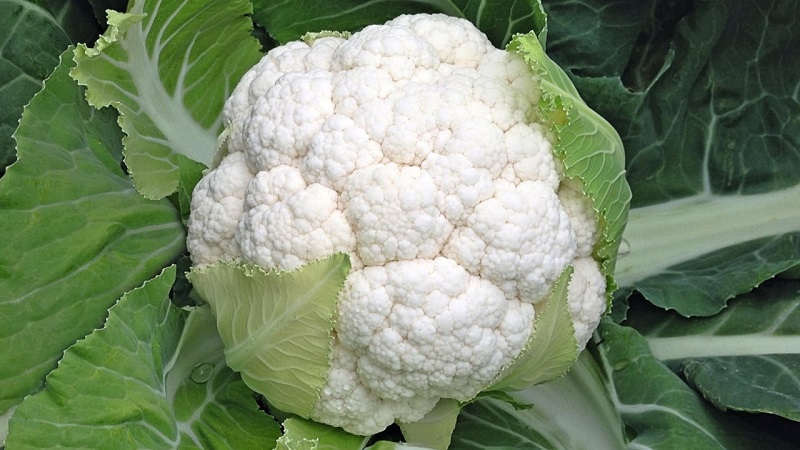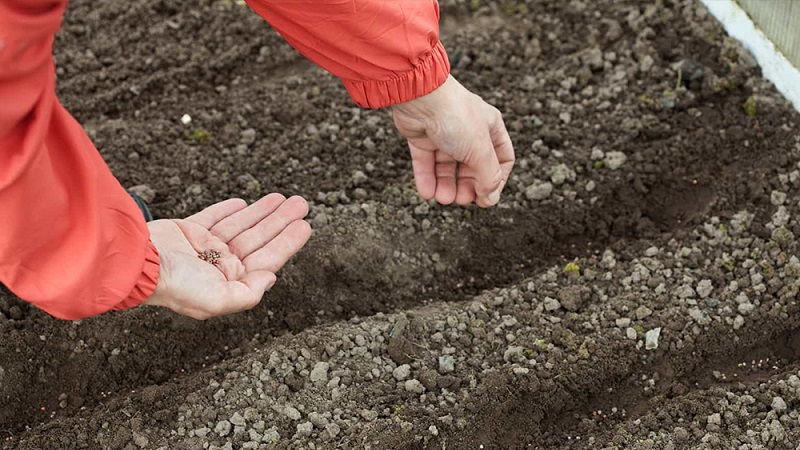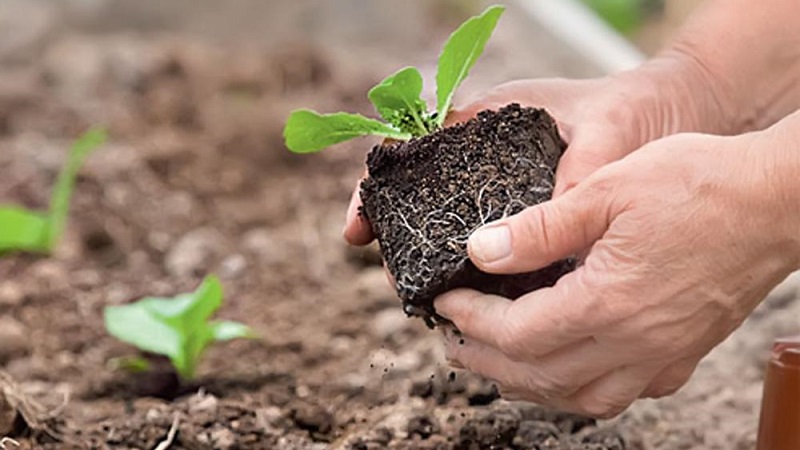How best to plant cauliflower: seedling and seedless methods
Cauliflower has gained popularity among gardeners due to its pleasant taste, rich chemical composition, high nutritional value and hypoallergenicity. This is a very capricious crop, but subject to agrotechnical requirements, even novice vegetable growers can get a rich and high-quality harvest. We will tell you in detail about the rules for planting cauliflower in the ground and its care requirements.
The content of the article
How to plant cauliflower directly in open ground
Cauliflower is grown in seedling and non-seedling ways... Both technologies are productive, but they have some peculiarities. So, sowing seeds directly into open ground is most often used in the southern regions and central Russia, choosing for this early and mid-season varieties.

Variety selection
The most suitable varieties and hybrids for planting in open ground cauliflower are described in the table.
| Ripening period | Variety / hybrid | Description |
| Early ripe | polar Star | Heads of cabbage are round-flat, small-knobby, whitish, weighing 0.8 kg each. Marketable yield - 2.9 kg / m². |
| Movir 2009 | Heads of cabbage are dense, reaching 18–20 cm in diameter and weighing up to 1 kg. Productivity - 2.7 kg / m². | |
| Medium early | Patriotic | Heads of cabbage are white, round-flat in shape, dense. Average weight - up to 1 kg, marketable yield - 0.9-3 kg / m². |
| Goat dereza | Heads of cabbage are medium-convex, dense, white, weighing 680–800 g each. Marketable yield - 3.1 kg / m². | |
| Balboa F1 | Heads of cabbage are dense, closed, white, weighing up to 1.2–2 kg. Productivity - up to 3.9 kg / m². | |
| Mid-season | Purple ball | The heads are round-flat, dense, purple, weighing up to 1 kg. Productivity - 2.9 kg / m². |
| Parisian | Heads of cabbage are round-flat, whitish, dense, weighing 750 g each. Marketable yield - 2.5 kg / m². | |
| Late ripening | Green snowdrift | Heads of cabbage are round, partially covered, bumpy, green, weighing 740-840 g. Productivity - 2.1 kg / m². |
| Skywalker F1 | The heads of cabbage are dense, uniform, white, tightly closed with inner leaves, weighing up to 3.5 kg. Productivity - 3.5-5.6 kg / m². |
Sowing dates
Sowing seeds in open ground is carried out in May... More precise dates depend on the variety, the period of its ripening and the climatic conditions of the region.
The main thing is that the soil warms up to at least + 10 ° C, and the average daily air temperature at the time of sowing was at least + 6 ° C (this is the minimum indicator for seed germination).

Soil preparation
For cauliflower, choose a well-lit area, protected from gusty winds and drafts.... The crop prefers fertile, loose soil with good aeration, moisture permeability and low or neutral acidity (pH 6.7-7.4). The best option is sandstone and loam.
Reference. Lime or dolomite flour is preliminarily introduced into acidic soil, otherwise the risk of damage by cabbage keel increases.
In autumn, the site is dug up and 7-8 kg of manure or compost and 1.5 kg of ash per 1 m² are introduced... In the spring, re-digging is carried out with the addition of mineral fertilizers: 25 g of ammonium nitrate, 50 g of potassium salt and 25 g of superphosphate per 1 m².
Sowing cauliflower
Seed sowing technology:
- In the prepared area, form rows at a distance of 25-30 cm from each other.
- Make planting holes in them with a diameter of 4-5 cm and a depth of 1-2 cm, keeping a distance of 60-70 cm between them.
- Water the soil with warm water.
- Place 2-3 grains in each hole, sprinkle with soil or humus, slightly compact.
- Cover the beds with plastic wrap to protect the cabbage from recurrent frost.
Seeds germinate 7-10 days after sowing... When 3-4 leaves are formed on the seedlings, the weak plants are removed, cutting them off with sharp scissors at the very base in order to eliminate the risk of damage to the roots of strong seedlings.
Further care
On average, cauliflower is watered once every 4-7 days at the rate of 10 liters of water per 1 m²... To retain moisture, the soil is mulched with rotted sawdust or mowed grass.
Reference. Waterlogging of the soil provokes rotting of the roots, and drying out of the soil during ovary formation - decrease in yield.
After watering or rain, the ground is loosenedto improve its moisture permeability and aeration. At the same time, they get rid of weeds, and to enhance the growth of roots, the plants are regularly spud.
Fertilizers are applied according to the scheme:
- 2 weeks after emergence or transplanting seedlings into the ground - a solution of urea (20–25 g per bucket of water) or mullein at the rate of 5 liters per 1 m²;
- after 14 days - mullein solution with the addition of 1 tbsp. l. "Kristalona", at the rate of 1 liter per plant;
- after 2 weeks - 6-8 liters of nitrophoska solution (2 tablespoons per 10 liters of water) per 1 m².
After the start of tying the heads, the application of nitrogen fertilizers is stoppedto avoid the accumulation of nitrates in cabbage.
Important! With a shortage of boron and molybdenum, the heads of cabbage are formed small, and the leaves are narrow and inconspicuous.
After tying the first inflorescences, they are shaded with 2-3 adjacent leaves... To do this, they are collected in a bunch and secured with an elastic band or clothespin. If this is not done, the heads will turn yellow and become stained.

Prevention and treatment of diseases:
- Alternaria - pre-planting seed treatment with "Planriz", spraying with Bordeaux liquid, colloidal sulfur or copper sulfate;
- keela - adding lime or dolomite flour before planting and under the root of cabbage;
- ring spot - treatment with fungicides ("Agatom", "Bravo");
- slimy bacteriosis - spring treatment with a suspension of colloidal sulfur;
- vascular bacteriosis - treatment with "Trichodermin" and "Planriz";
- fusarium - watering with "Fitosporin-M" solution, treatment with "Fundazol";
- black leg - pre-planting seed treatment with potassium permanganate solution, soil disinfection with formalin;
- peronosporosis - treatment with fungicides ("Vectra", "Quadris", "Kurzatom");
- mosaic - the disease does not respond to treatment, the affected specimens are destroyed.
To scare off slugs and caterpillars, the soil in the aisles is treated with dry mustard, lime or ash. To combat aphids, plantings are sprayed with garlic, pepper or chamomile solution, and cabbage flies are disposed of with tobacco dust. In case of severe damage, the plants are treated with insecticides ("Aktara", "Tanrek", "Biotlin").
Interesting on the site:
How to store cauliflower properly
The method through growing seedlings from seeds
The seedling method of growing cauliflower is used by most gardeners. His the main advantage is an accelerated harvest.

When and how to sow for seedlings
Seeds of early maturing varieties are sown for seedlings at the end of February, mid-season - in mid-March, late - at the end of March.
Planting material is pre-processed to improve germination and disinfection. To do this, the seeds are dipped in hot (+ 45… + 50 ° C) for 15–20 minutes, and then in cold water for 2-3 minutes. Then, for 8-12 hours, they are soaked in a solution of a growth stimulant (Kornevin, Heteroauxine) and potassium permanganate, thoroughly washed under running water and dried.
Sowing rules:
- Fill the prepared containers with a suitable substrate (peat, river sand, humus and rotted mullein in a ratio of 2: 1: 1: 1).
- Make a depression of 1 cm maximum.
- Place a grain in the center, sprinkle it with sand.
- Moisten the substrate with a spray bottle.
- Cover the container with plastic or glass.
Containers with crops are removed in a bright place with an air temperature of + 18 ... + 20 ° C... The shelter is removed after germination.
Care and conditions for seed germination
To avoid pulling the cabbage, after germination of seeds, the air temperature in the room with the seedlings is reduced for 5 days to + 6 ... + 8 ° C, and then maintained within + 15 ... + 18 ° C during the day and + 8 ... + 10 ° C at night. The optimum humidity level is 70–80%.
Important! Temperatures of + 21 ° C and above lead to the absence of ovaries on the inflorescences.
Watering is carried out on average once a week, preventing waterlogging and drying out of the substrate... When 2-3 leaves are formed on the seedlings, the seedlings are fed with wood ash (1 tbsp per 10 l of water) or a mullein solution in a ratio of 1:10.
When sowing seeds in a common container after the emergence of 2 leaves on the seedlings, a pick is carried out - the plants are planted in individual containers. After that, the seedlings are kept at a temperature of + 21 ° C, and when they take root - at + 17 ° C during the day and + 9 ° C at night.
10 days before transplanting into the ground, plants begin to harden... To do this, they are taken out into the open air, gradually increasing the time spent there from 5 minutes to a day.
How to plant cauliflower seedlings outdoors
The timing of planting seedlings on the beds depends on the time of sowing the seeds. Plants should be 45-50 days old.
Transplant instructions:
- Form on the site rows with a row spacing of 50 cm.
- Make planting holes every 20–40 cm (depending on the variety of cabbage).
- Add to each handful of humus and 1 tbsp. l. wood ash.
- Remove the plants from the containers and place in the center of the holes, deepening to 1 true leaf, sprinkle with soil, compact and water.
With an early transplant, the beds are covered with polyethylene to protect them from recurrent frost.
Conclusion
Cauliflower is a very capricious crop that is grown in seedlings or non-seedlings. But despite its exactingness, it will be possible to get a rich harvest of useful vegetables if all the rules of agricultural technology are followed: adherence to planting dates, selection of a suitable site and the right substrate, timely watering and fertilization.